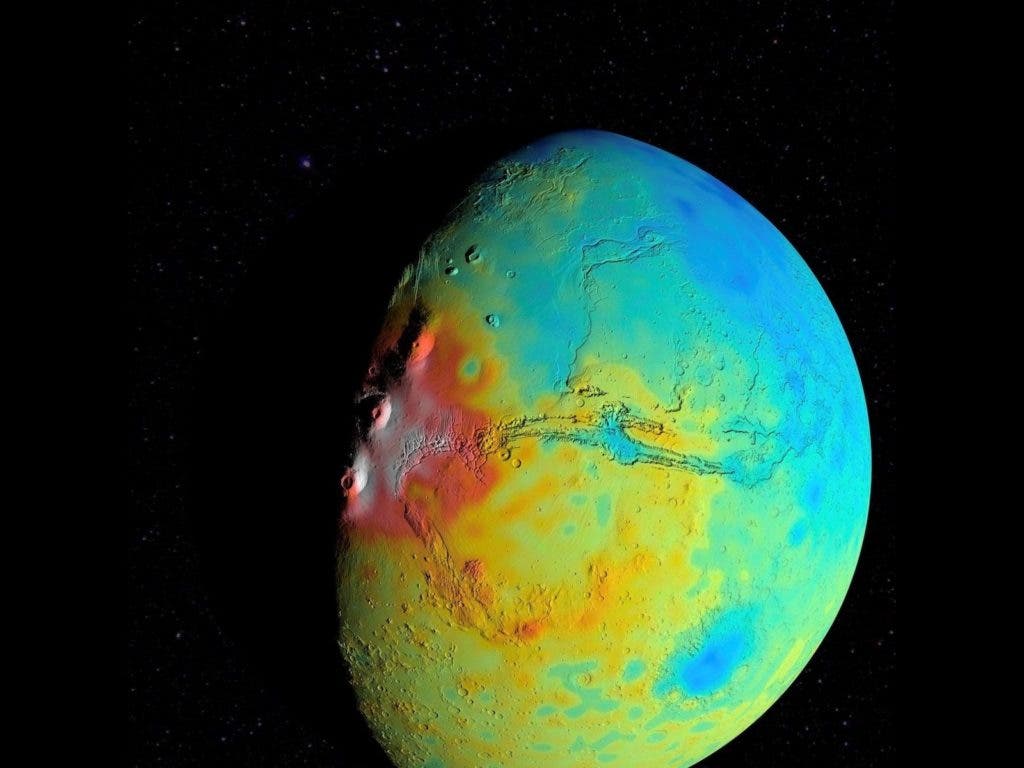This could help us better understand the Red Planet and its evolution.

A gravity map of Mars. Martian gravity can reveal a lot of the planet’s secrets, especially those of its crust. Credits: NASA/Goddard/UMBC/MIT/E. Mazarico.
Gravity on our planet isn’t uniform at all. Sure, it might seem that way to our human senses, but there are lots of variations, depending on the Earth’s subsurface and variations in its shape. For instance, denser rocks will lead to a slightly stronger gravitational field, whereas those with pores or voids lead to a weaker local field.
We’ve long created general gravity maps of the Earth and even localized, detailed maps. Even the Moon has been charted in detail, using NASA’s GRAIL mission, which sent two space probes to study the field. Since gravity decreases with distance, things closer to the surface have a stronger impact than things deeper in the underground, and now we have a significantly better understanding of the Moon’s crust (which has a more pronounced effect on the gravity field).
In fact, crustal density and gravity have many things in common — we can derive one from the other, through a sophisticated mathematical process called inversion. Map the gravitational field, and you’ll learn a lot about the density — you could even build a density model, as we’ve done for Earth. But using the same approach with Mars would be difficult because we just don’t have enough data, so NASA had to try a different strategy.
They used what little gravitational information we have about Mars, relying on what little we learned directly about the Martian surface and even more on the topography of the planet. They learned that Mars has a lighter crust than what was expected, based on what we know of the rocks’ composition. Researchers were expecting rocks about as dense as the oceanic crust here on Earth, but they came up with less than that.
“As this story comes together, we’re coming to the conclusion that it’s not enough just to know the composition of the rocks,” Greg Neumann, a researcher on the project, said in a statement. “We also need to know how the rocks have been reworked over time.”
The final density figure is 2,582 kilograms per meter cubed (about 161 pounds per cubic foot). That’s comparable to the average density of the lunar crust and significantly less than Earth’s oceanic crust, which is about 2,900 kilograms per meter cubed (about 181 pounds per cubic foot). This seems to indicate that the main culprit for this difference, the crust, is more porous than we initially thought.
“The crust is the end-result of everything that happened during a planet’s history, so a lower density could have important implications about Mars’ formation and evolution,” said Sander Goossens of NASA’s Goddard Space Flight Center in Greenbelt, Maryland. Goossens is the lead author of a Geophysical Research Letters paper describing the work.
Before publishing these results, they tested their method using data from the GRAIL mission and came up with accurate results. They also correlated positive anomalies (stronger gravitational field) to known volcanoes, something which was expected. But the approach they used doesn’t have a good resolution, so we’ll have to wait for more data to confirm these findings.
The researchers also note that NASA’s InSight mission — short for Interior Exploration using Seismic Investigations, Geodesy and Heat Transport — will carry out the measurements which could confirm their finding. This Discovery Program mission, scheduled for launch in 2018, will place a geophysical lander on Mars to study its deep interior.
You can study the model and even download on this page from NASA’s website.
Journal Reference: Sander Goossens, Terence J. Sabaka, Antonio Genova, Erwan Mazarico, Joseph B. Nicholas, Gregory A. Neumann. Evidence for a low bulk crustal density for Mars from gravity and topography. DOI: 10.1002/2017GL074172









